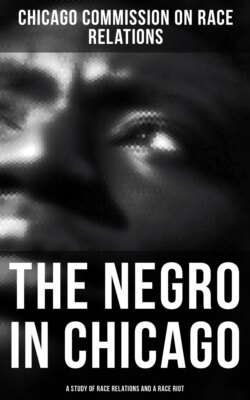Читать книгу The Negro in Chicago - A Study of Race Relations and a Race Riot - Chicago Commission on Race Relations - Страница 45
На сайте Литреса книга снята с продажи.
IV. TREND OF THE NEGRO POPULATION
ОглавлениеIn considering the expansion of Negro residential areas, the most important is the main South Side section where more of the Negro population lives. This group is hemmed in on the north by the business district and on the west by overcrowded areas west of Wentworth Avenue, called in this report "hostile." During the ten years 1910–20 business houses and light manufacturing plants were moving south from the downtown district, pushing ahead of them the Negro population between Twelfth and Thirty-first streets. At the same time the Negro population was expanding into the streets east of Wabash Avenue. This extension was stopped by Lake Michigan, about eight blocks east. Negro families then began filtering into Hyde Park, immediately to the south.
In 1917 the Chicago Urban League found that Negroes were then living on Wabash Avenue as far south as Fifty-fifth street east of State Street, where they had moved from the district west of State Street. From Thirty-first to Thirty-ninth streets, on Wabash Avenue, Negroes had been living from nine to eleven years, and the approximate percentage of Negroes by blocks ranged from 95 to 100; from Thirty-ninth Street to Forty-seventh Street they had been living from one to five years and averaged 50 per cent. The movement had been almost entirely from the west and north.
On Indiana Avenue, from Thirty-first to Forty-second streets, a similar trend was revealed. In the 3100 block, Negroes had been living for eight years, in the 3200 block for fourteen years; in the more southerly blocks their occupancy had been much briefer, ranging down to five months. In the most northerly of these blocks Negroes numbered 90 per cent and in the most southerly only 2 per cent.
On Prairie Avenue, farther east, two Negro families bought homes in the 3100 block in 1911, but the majority of the Negroes had come in since 1916. The percentage of Negroes in that block was 50. From Thirty-second to Thirty-ninth Street the blocks were found to have more than 90 per cent Negroes. One family had been there five years and the average residence was one and one-half years. No Negroes were found from Fortieth to Forty-fourth Street on Prairie Avenue. There were two families in the 4500 block, and none south of that.
On Forest Avenue, from Thirty-first to Thirty-ninth Street, 75 per cent of the families were Negroes and had lived there less than six years.
On Calumet Avenue, the next street east of Prairie, Negroes had begun to live within four years. The population was 75 per cent Negro from Thirty-first to Thirty-ninth Street. None live south of Thirty-ninth Street, except at the corner, where they had been living for five months.
A similar situation was found on Rhodes Avenue, still farther east, from Thirty-first to Thirty-ninth Street. Negroes had lived in Vincennes Avenue, the next street east, less than two years, and in Cottage Grove Avenue, still farther east less than one year.
South Park Avenue and its continuation, Grand Boulevard (south of Thirty-fifth Street) was the most recent street into which Negroes had moved in large numbers. This had occurred within the years 1915–17. The first Negro families had moved into the 3400 block less than four years previously. The percentage of Negroes between Thirty-first and Thirty-fifth streets was less than 50. Within five months two Negro families had moved into the hitherto exclusively white 3500 block.
Few Negroes had moved from east of State Street to west of that street.
